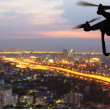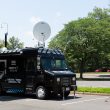A Real Stumper
Are Among the Background Noises that first responders often encounter while using their public-safety radios at an emergency scene. Understandably, such ambient noise interferes with the ability to hear and understand what people are saying on a radio — regardless of whether they are digital or analog radios. Now, vendors find themselves experimenting with multiple solutions designed to significantly improve interference problems, but which likely will never solve them completely.
The problem has come to the forefront in recent months as firefighters in particular have reported interference problems with their digital radios when using them in the presence of loud background noise — not only from the power tools often used on the fireground, but also from alert mechanisms associated with a firefighter’s breathing apparatus. Last summer, the National Telecommunications and Information Administration (NTIA) tested three different communications systems used in public-safety digital radios — 25 kHz analog, Project 25 full rate IMBE and P25 enhanced full rate AMBE — and found that all three failed to deliver intelligible communications in four of the nine fireground environments tested.
While the International Association of Fire Chiefs (IAFC) subsequently released a detailed report (“Lessons worth learning,” January 2009) on how firefighters can mitigate such problems through best practices, vendors are being challenged to come up with improved products — a task that is not easy given the varying noises and emergency situations that firefighters face.
While both analog and digital systems have failed in tests when background noise is introduced, most vendors are focusing on making digital systems better in anticipation of the industry moving toward these purportedly more efficient systems. But digital radios are inherently more complex when it comes to background noise because they contain the aforementioned vocoders, software that converts human voice into data bits for transmission and reconverts the digital signal back into voice on reception. The vocoders used in P25 radios can provide only a rough replication of the human voice, said Don Wingo, director of research and development for radio vendor Kenwood USA.
“It’s a predictive vocoder, which means you have a channel that is a limited-bandwidth channel. It’s like cutting a piece of pie and having 50 people on one slice of pie. Some are going to get a virtual piece of pie because you can’t cut it thin enough,” Wingo said.
“When you have a 12.5 kHz channel and you take a voice waveform and you start cutting it up, I have to sample at a higher rate to get better audio quality,” he continued. “I can only cut it so fine. If I cut it too fine, it takes up more bandwidth than I have available. So [vocoders] make predictions in areas that they can actually sample in.”
Moreover, all noises the vocoder picks up — background noises and speech — are converted in the same manner. “If the noise signal is higher than the voice signal, that is when I have the issue. It all boils down to the signal-to-noise ratio between the speech and the background noise,” Wingo said.
John Hardwick, president of Digital Voice Systems, which provides the vocoder for P25 radios, said his company has improved upon its original vocoder for digital radios to include noise suppression, which vendors say offers better quality but is not enough by itself. Hardwick agrees with that assessment.
“There’s always just so much a vocoder can do,” Hardwick said. “An enhanced vocoder makes a difference for a broad range of noise conditions, but generally there is some noise in just about any environment. … It’s not a magic bullet.”
If that wasn’t enough, the issue of narrowbanding is likely to create more vocoder challenges, as the FCC has indicated its intention to have public-safety communications systems eventually operate on 6.25 kHz channels.
“The real issue here is the compression issue — the issue that we have to operate with less spectrum,” IAFC senior adviser Alan Caldwell told Urgent Communications last summer after NTIA released its interference test results. “Therefore, you’re trying to compress all this into a smaller swath of electromagnetic particles, and it just makes it more difficult.”
NO PANACEAS
That leaves radio vendors looking for ways to make sure too much noise doesn’t enter the vocoder in the first place. On one level, radio vendors are effectively filtering the noise out of the signal before it enters the vocoder and raising the voice signal higher than the background noise so that the offending noise doesn’t dominate the signal.
“We had two engineers spend a year-and-a-half studying audio,” Wingo said. “We try to pre- and post-process the audio and baseband signal before they travel to the vocoder. In doing that, we’ve been able to clean up the baseband audio so that the audio process is good. That has made a big difference.”
Eric Brooks, vice president of engineering with Motorola’s government and public-safety business, said the vendor also incorporates noise-processing technology. Motorola has been including upgradable software, called Noise Shield Technology, in its XTS portable radio line. The software uses a series of algorithms in the digital signal processor (DSP) to accurately filter out the caller’s voice from background noise, attenuating the noise before it reaches the vocoder and creating more intelligible audio.
“Vendors have to come at this from a variety of angles,” Brooks said. “We have to find ways to deliver the best possible signal we can, and that may include looking at how the microphone is sealed in the box, improving DSP technology or enhancing the microphone port. We need to look at each one and deliver the best scenario.”
More recently, Motorola introduced the APX 7000 multiband P25 portable radio designed to provide 50% louder audio than its XTS 5000 series, with far less distortion. This is possible because the device includes more sophisticated DSP techniques and two microphones to offer greater audio sensitivity and clarity. With a single microphone input channel, traditional portable radios can remove only a relatively small amount of the background noise from the combined speech plus background noise signal, but a dual microphone — one on the audio side and one on the data side — can pick up sound from various angles and transmit those signals into an intelligent DSP where background noise is suppressed and filtered.
“We wouldn’t say this is an overall solution to all noise problems, but we’d say it’s a noticeable and measurable improvement,” Brooks said. “It can’t be something that is a panacea for every noise environment.”
Indeed, the noise environment in which police officers, for instance, operate is different than what firefighters face. The challenge then becomes: How do vendors come up with a product that caters to a variety of these situations?
“Noise can’t simply be characterized as having a singular nature. Some noise is steady in amplitude and frequency while other noise is not. That makes it difficult to tackle from an engineering point of view, but not impossible,” said John Facella, director of public-safety markets for Tyco Electronics Wireless Systems, formerly known as M/A-COM.
NO EASY ANSWERS
This is no more apparent than in the firefighter community. Firefighters indicate significant radio intelligibility problems associated with background noise in digital systems when a firefighter is using a self-contained breathing apparatus (SCBA) mask or a personal alert safety system (PASS), an allegation that is supported to some degree by the NTIA’s research.
“If you are a firefighter that is fully suited, using a self-contained breathing apparatus, in the interior of a building and an air tank on your back, you have a whole set of challenges acoustically,” Facella said.
In this scenario, a firefighter may be holding the radio microphone close to the SCBA mask’s amplifier, subjecting the microphone to the loud background noise and the muffled voice that is coming from the mask. As a result, manufacturers need to consider embedding the microphone and ear piece inside the safety mask, said Chris Baker, a fire captain and paramedic with the Roseville (Calif.) Fire Department.
The IAFC is addressing such needs with public-safety vendors. But Wingo said the industry needs to reach out to other players in similar industries to help solve these problems. For instance, the vendor community has not had a close relationship with SCBA mask manufacturers in the past. That needs to change in order to come up with a comprehensive solution. And companies that provide noise-suppression techniques for other industries also must be brought to the table, he said.
Because firefighters have different needs from police officers, the industry could well become segmented, Facella said. But he and others in the public-safety community say such specialization could drive the cost of radios even higher.
“What we lack is economies of scale, and if we do it that way, we are pushing ourselves back to a situation where these radios will still be in the $1000 price range,” Wingo said. “We’ve got to get the pricing down so everyone is comfortable.”
However, Baker and public-safety vendors see some room for differentiation on the software side.
“With radios moving toward being software-defined, I don’t see why vendors can’t make features — such as active noise canceling — and sell them as options,” Baker said.
Indeed, Kenwood already offers some feature sets that cater to certain public-safety segments. For instance, according to Wingo, the company often customizes firmware for particular users to include specific feature sets such as the ability to easily switch between analog and digital modes. On Motorola’s XTS line of radios, the enhanced noise-suppression feature can be enabled or disabled depending on the use.
In the end, finding answers to background noise problems won’t be easy. Not only must vendors find ways to cater to the demanding needs of the various players in the public-safety community, but new noise-suppression solutions will be stymied by the fact the turnover rate of public-safety radios is slow.
“There aren’t easy answers,” Facella said. “That is why the problem is going to take a wee bit of time to sort out. We have to find the technical solutions that apply in the right use cases and find a way to make radios available to a large continuum of user bases. We are working on it.”
That leaves public-safety users, particularly firefighters, to incorporate the best-practices recommendations to improve fireground communications as much as possible, given the current technology. That includes speaking in a loud, clear and controlled voice to maximize radio intelligibility — which vendors and the rest of the public-safety industry acknowledge is easier said than done in an emergency situation.
Moreover, Wingo said vendors need to take the time to train public safety on using digital radios, which behave differently than analog devices.
“It really is critical that we train people on how to use the digital radio. That is not taken into consideration many times,” he said. “We as manufacturers need to spend less time concentrating on selling something and more time on training, so that end users understand clearly how a digital radio behaves.”

















